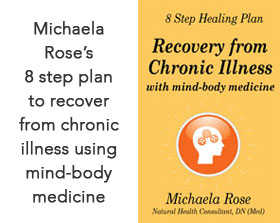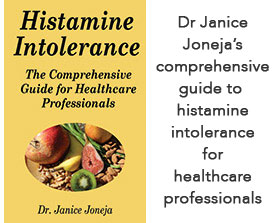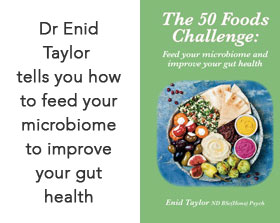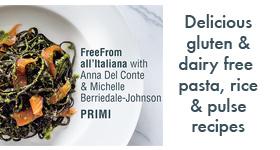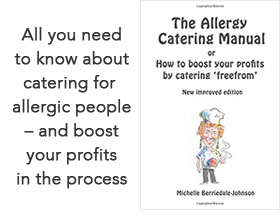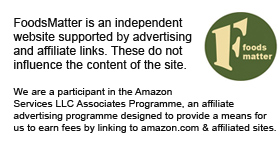|
Although it seems illogical, legally, in medico speak,
and in commercial parlance, ‘'dairy free' means cows' milk
free, not animal milk free. In the real world those who react to
lactose (the sugar found in all animal milks including human) will
probably react to all animal milks, but those who react to specific
proteins in cows' milk may be able to tolerate goat, sheep
or buffalo milk.
If dairy sensitivity strikes in infancy (Dairy
free infants & toddlers) the problem is not to diagnose but to deal with
it. But if it strikes in childhood
or as an adult, you need first to identify dairy as the problem before
you dramatically alter your diet to exclude it.
It is possible to be mildly dairy intolerant, but relatively symptom free, for a long period but for the sensitivity to suddenly become more acute because of some other health problem.
It is also possible for a sensitivity to be brought
on by an outside event. This could be any kind of physical or psychological
trauma (viral infection, accident, emotional crisis, depression)
but is most often a digestive episode. Many sensitivities arise after
a serious bout of gastroenteritis, often travellers' gastroenteritis,
when the balance of the gut flora has been upset. The gut wall may
also have been damaged and become ‘'leaky' or the lactase
enzyme which digests the lactose sugar in the milk may have been
washed out of the system by diarrhoea. The result of any of these
events is that undigested or semi digested milk proteins or lactose
either remain too long in the gut or get through the gut wall into
the blood stream. Sometimes they can even breach the blood/brain
barrier to reach the brain causing mood and behaviour problems such
as depression or mood swing in adults, hyperactivity or ADHD in children.
Symptoms
Although the symptoms of dairy sensitivity can be almost limitless, as with so many foods, some crop up very regularly. If, for whatever reason, there is insufficient lactase enzyme in the gut to digest the lactose sugar, the latter ferments and causes wind, cramping and diarrhoea - this is lactose intolerance.
Milk protein intolerance or allergy may also cause digestive symptoms - vomiting, wind, bloating, cramps, diarrhoea and constipation. However it may also cause breathing problems or ENT issues (rhinitis or runny nose, otitis media, glue ears, sore throat, hay fever, asthma), skin problems (urticaria, eczema) and behavioural problems (depression, mood swings, ADHD). But such is the nature of dairy sensitivity, that it can cause almost any symptom in the world.
In rare cases a milk sensitivity can be very severe and cause anaphylactic shock in which the mouth and airways swell up, breathing becomes difficult and blood pressure drops dramatically. This can be fatal - see below.
Diagnosis
Because of the risk of serious reactions if you suspect a dairy sensitivity you must always visit your GP for a milk allergy test. Allergy is easy to diagnose via a blood test and if you are at risk you will be given an Epipen with which to inject yourself to counteract any reactions.
Diagnosing a food intolerance rather than a food allergy is more difficult both because reactions can occur up to 3 days after you have eaten the food, and because you may be reacting to more than one food.
Exclusion diet
The only diagnostic technique recognised by conventional medicine
is ‘'exclusion and challenge'. And to be fair, this is
what all the tests mentioned in the box suggest as the way to validate
their results. All it means is that you exclude the suspect food
- in this case dairy - completely from your diet for a period of,
say, 2 weeks and see if your symptoms improve. If they do, then you ‘'challenge'
yourself by re-introducing the dairy to your diet and see whether
your symptoms
return. If they do return it is reasonable to assume that you are
at least temporarily sensitive to dairy products and should exclude
them from your diet.
This exclusion should go on for at least three months. If your sensitivity was caused by other health problems which have in the meantime been addressed (digestive damage, exhaustion, viral illness, emotional upset etc) you may well find that you are once more able to tolerate dairy products. Even so it would be wise to continue to eat them in moderation.
If however the sensitivity was more deep rooted (the digestive damage greater or general health problems more serious) you may have to continue to exclude dairy on a longer term or even a permanent basis. However, depending on the degree of your sensitivity, you may be able to relax your diet slightly.
Identifying dairy products
One of the hardest things, when you set out on a dairy free diet, is being able to identify the ingredients/foods that you need to avoid. This is especially difficult with dairy as so many ingredients (whey, casein and lactose in particular) are widely used in the manufacture not only of foods but supplements, medicines and even something as unlikely as condoms!
As with any food sensitivity you will need to become an avid reader of labels and be suspicious of every unlabelled food that you eat in a restaurant or outside your own home and control.
Below we give a table with the ingredients you need to look out for and the foods you are most likely to find them in.
Replacing dairy products
It is all very well excluding dairy products from your diet but what are you going to eat instead?
Dairy products do provide us with a great deal of very useful nutrition so it is important that, if you are going to exclude them, you replace them with alternative sources. The second and third tables below suggest reasonable substitutes for regular cows’ milk, butter, ice cream etc and foods which will replace the nutritional elements, especially calcium, which is normally derived from dairy products.
Finally, we are listing some books and websites that you may find useful in coping with a dairy sensitivity.
Dairy products: includes milk, cream, butter, cheese, yogurt
- but NOT eggs.
Remember the term 'Dairy free' only means cows'
milk free, not sheep, goat or other animal milk free.
Other names for dairy products:
Butter and buttermilk
Casein / caseinates
Cheese including cream, curd and cottage
Cream - all varieties
Creme fraiche and fromage frais
Ghee
Ice cream
Lactalbumin, lactic acid (E270)
Lactose
Liquid milk of all kinds
Milk solids and skimmed milk powder
Whey / whey protein / sugar
Yogurt
Are likely to be found in:
Animal fat
Artificial cream
Batter (for pancakes, waffles, fish fingers etc)
Biscuits - most include butter or margarine
Breads - enriched beads will include butter and/or milk - and scones
Cakes - most use butter and many use milk
Cheese straws/biscuits
Cheese flavoured crisps
Creme caramel / creme patissiere / custard
Chocolate/chocolate products
Desserts - many different kinds
Ice creams - most types
Low fat spreads and margarine
Ready meals - most ready meals include
butter or milk
Rice pudding and most other baked puddings
Sauces - all white sauces and many other ready made sauces
Sweeteners
Vegetable fats
Non-Foods: condoms
Alternatives:
Goat, sheep and buffalo milk, cream, butter, yogurt and cheese
If you can tolerate them all these milks are now quite easily obtainable fresh, frozen or UHT. They behave like cows’ milk and can be substituted for it in most dishes. They can also be used in milk shakes, ice cream and cappuccino as they have relatively high fat contents. Goat cream (the only cream available) also whisks well. Yogurt and cheese are delicious and easily available; goat butter is delicately flavoured and yummy.
Soya milk, cream, yogurt and cheese
Soya milk comes in many shapes and sizes: sweetened and unsweetened, flavoured and plain, fortified and unfortified. Most modern soya milks have lost their ‘beany’ taste and are very widely available. Most cook up well in sauces and soups but some separate if used in hot tea or coffee.
Soya cream works like pouring cream; soya yogurts, plain and fruit flavoured, are excellent. Soya cheeses do not taste anything like regular cheese although some of the slices melt OK for pizzas or sandwiches.
Rice milk
Rice milk is thinner than animal or soya milk and naturally sweet. Some brands are rather watery. It comes plain and flavoured. It works well in sweet dishes but not in savoury ones, or in tea or coffee.
Oat milk
Early brands bore a strong resemblance to liquid porridge but more recent ones are fairly innocuous. Good for savoury dishes, not for sweet ones or in hot tea or coffee.
Coconut milk and cream
Excellent rich milk for drinking and cooking to which very few people react but with a very distinct flavour. Liquid coconut milk comes in tins and can be used, well stirred, direct from the tin. Coconut cream comes as a solid block which needs to be broken down with hot water.
Dairy free spreads
There are a number of dairy free spreads on the market but scrutinise ingredients carefully as many vegetable etc. spreads contain whey or casein. Most spreads are relatively harmless and can be used instead of butter on bread, and in sauces and baking (pastry, cakes etc) although they are not good for frying for which you can substitute an oil.
Replacing 'dairy' nutrients
Calcium: Broccoli, leafy green vegetables, nuts, pulses, root vegetables, sardines or other tinned or fresh fish with the bones in.
Iodine: Seaweed/kelp, fish and seafood, pineapple, raisins
Vitamin A: Fish liver oils, offal
Vitamin B1: Whole grains, pulses, brown rice, potatoes and peas
Vitamin B2: Eggs, liver, yeast, pulses and whole grains
Vitamin B12: Eggs, fish, liver, meat
Dairy Free Books & Websites
Enjoying Life with a Severe Food Allergy by Tanya Wright (Class Publishing)
The Complete Guide to Food Allergy & Intolerance by Prof. Jonathan Brostoff & Linda Gamlin (Bloomsbury)
AIA - Gluten and Dairy Free Cookbook by Marilyn le Breton (Jessica Kingsley)
Optimum Nutrition for Babies & Young Children by Lucy Burney (Piatkus Books)
The Everyday Dairy Free Cookbook by Miller Rogers and Emily White (Grub Street)
Websites
www.milkfree.org.uk
An informative, helpful and friendly site run by the parents of a dairy allergic child. Definitely worth a browse.
www.lactoseintolerance.co.uk
Excellent and informative site dealing with lactose intolerance.
www.lactose.co.uk
Site for lactose intolerance, milk allergy and IBS. Also information about food colours and additives that cause allergies, especially in children.
www.foodcanmakeyouill.co.uk
An interesting site with a lot of good research reports on food allergy/intolerance run by Sharla Race, a food intolerant herself, who has written several books on restricted diets.
www.allergicchild.com
Created by the parents of two children with allergies. Has information, links and books on various food and other allergies.
First published in 2004. Updated April 2013.
|

